

Augmented Reality for Learning. Augmented Reality (AR) can be defined as “a real-time direct or indirect view of a physical real-world environment that has been enhanced/augmented by adding virtual computer-generated information to it” (Carmigniani & Furht, 2011, p.3).
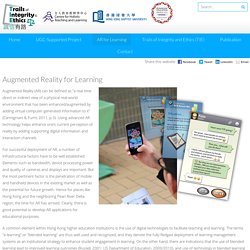
Using advanced AR technology helps enhance one’s current perception of reality by adding supporting digital information and interaction channels. For successful deployment of AR, a number of infrastructural factors have to be well established. 9 Amazing Augmented Reality Apps for Teaching and Learning. Augmented reality (AR) has evolved in recent years and its application in classrooms is limitless.
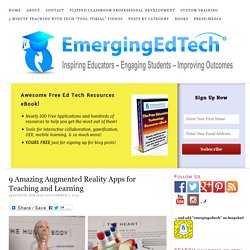
Educators don’t need to feel overwhelmed when trying to introduce AR in their classroom because there are many great apps that don’t require a lot of knowledge in the field. There are useful apps for every subject and there are also apps that when a teacher is ready they can create their own AR targets. Enhancing Student Learning with Augmented Reality. Augmented Reality Brings Interactive Learning to Classroom. The world is at a pinnacle moment of the Information Era, known as the New Media Age.
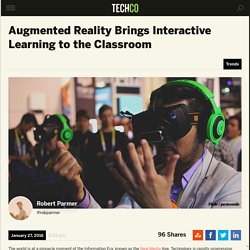
Technology is rapidly progressing at such a rate that many ideas still seem to be that of science fiction. On the roads, cars are literally driving themselves. UAV’s and drones are making advancements in some unexpected ways by aiding in efforts related to agriculture, law enforcement, and filmmaking. Innovative teaching through technology - Raconteur. With the rapid development of virtual and augmented reality, particularly in gaming, it’s only a matter of time before this technology is harnessed and fully implemented into the education and training market.

Suzanne Edwards, head of education and qualification design at Enlighten, says: “It’s great that learners are beginning to experience VR/AR on programmes of study but, as our research shows, education needs more support and investment to take full advantage of these innovative mediums.” With further education aiming to meet the criteria specified in the FELTAG (Further Education Learning Technology Action Group) agenda, schools working towards areas highlighted in the Department for Education’s 2020 Vision and prisons needing to address areas in the Unlocking Potential document, Enlighten have noticed a huge growth in demand for their quality eLearning services. Virtual and augmented reality are the next wave of computer technology. Octagon Studio's 4D+ Augmented Reality Flashcards. Augmented Reality in Education Series - Part 1: What is it? How to use Augmented Reality? Augmented Reality Brings New Dimensions to Learning.
Editor's Note: Drew Minock, who co-wrote this piece, is an elementary teacher, co-founder of the popular education blog Two Guys and Some IPads, and is one of the voices on "The Two Guys Show" podcast.
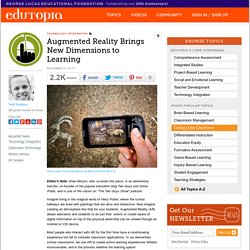
Imagine living in the magical world of Harry Potter, where the school hallways are lined with paintings that are alive and interactive. Now imagine creating an atmosphere like that for your students. Virtual Reality And Augmented Reality In Education - eLearning Industry. 5 reasons to use Augmented Reality in Education - Augment News. By integrating augmented reality into your lectures, you’ll capture the attention of your audience.
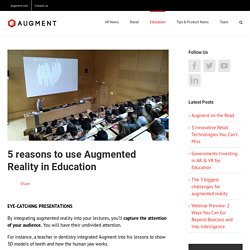
You will have their undivided attention. For instance, a teacher in dentistry integrated Augment into his lessons to show 3D models of teeth and how the human jaw works. Let your audience participate! Students are able to access models on their own devices via Augment’s app. By viewing augmented models, the students can gain a better understanding of the concepts they are studying. Augmented Reality For Education. EN103 web. Ar edu. How Augmented Reality Works. Video games have been entertaining us for nearly 30 years, ever since Pong was introduced to arcades in the early 1970s.

Computer graphics have become much more sophisticated since then, and game graphics are pushing the barriers of photorealism. Now, researchers and engineers are pulling graphics out of your television screen or computer display and integrating them into real-world environments. Augmented Reality.